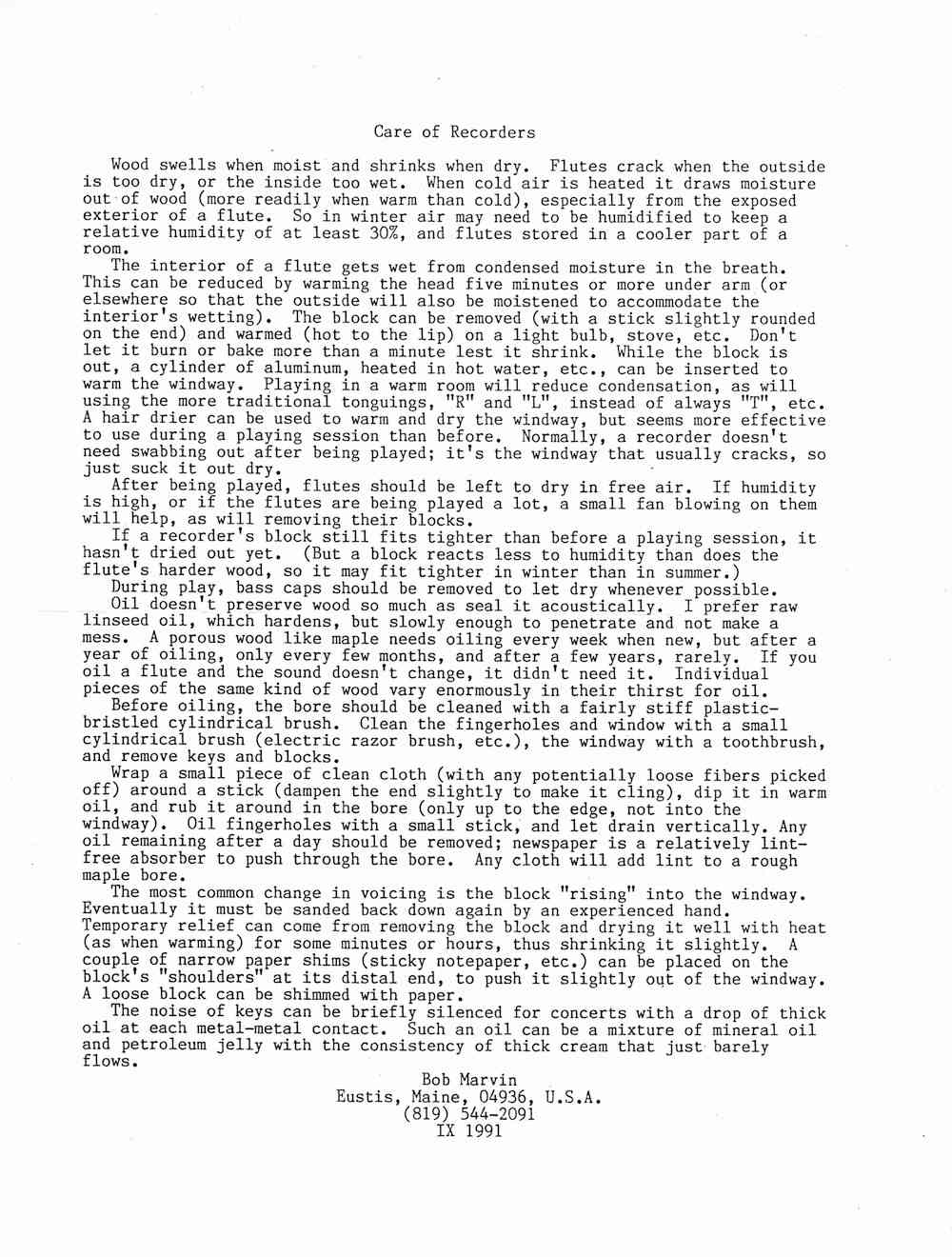«Cuidado y mantenimiento de las flautas», por Bob Marvin
Aquí tenéis un útil documento sobre el cuidado y mantenimiento de las flautas que Bob Marvin suele facilitar (cuando se acuerda) cuando entrega un instrumento. Data de 1991 y contiene consejos básicos e inteligentes trucos sobre aspectos como la reacción de la madera a la humedad, cómo calentar el instrumento antes de tocar, cómo aceitarlo, etc. Lo he estado consultando estos días durante una larga sesión de aceitado y limpieza de mis flautas, y he pensado que sería útil compartirlo aquí. Aquí va el texto de Bob:
Care of Recorders
“Wood swells when moist and shrinks when dry. Flutes crack when the outside is too dry, or the inside too wet. When cold air is heated it draws moisture out of wood (more readily when warm than cold), especially from the exposed exterior of a flute. So in winter air may need to be humidified to keep a relative humidity of at least 30%, and flutes stored in a cooler part of a room.
The interior of a flute gets wet from condensed moisture in the breath. This can be reduced by warming the head five minutes or more under arm (or elsewhere so that the outside will also be moistened to accommodate the interior’s wetting). The block can be removed (with a stick slightly rounded on the end) and warmed (hot to the lip) on a light bulb, stove, etc. Don’t let it burn or bake more than a minute lest it shrink. While the block is out, a cylinder of aluminum, heated in hot water, etc., can be inserted to warm the windway. Playing in a warm room will reduce condensation, as will using the more traditional tonguings, “R” and “L”, instead of always “T”, etc. A hair drier can be used to warm and dry the windway, but seems more effective to use during a playing session than before. Normally, a recorder doesn’t need swabbing out after being played; it’s the windway that usually cracks, so just suck it out dry.
After being played, flutes should be left to dry in free air. If humidity is high, or if the flutes are being played a lot, a small fan blowing on them will help, as will removing their blocks.
If a recorder’s block still fits tighter than before a playing session, it hasn’t dried out yet. (But a block reacts less to humidity than does the flute’s harder wood, so it may fit tighter in winter than in summer.)
During play, bass caps should be removed to let dry whenever possible.
Oil doesn’t preserve wood so much as seal it acoustically. I prefer raw linseed oil, which hardens, but slowly enough to penetrate and not make a mess. A porous wood like maple needs oiling every week when new, but after a year of oiling, only every few months, and after a few years, rarely. If you oil a flute and the sound doesn’t change, it didn’t need it. Individual pieces of the same kind of wood vary enormously in their thirst for oil.
Before oiling, the bore should be cleaned with a fairly stiff plastic-bristled cylindrical brush. Clean the fingerholes and window with a small cylindrical brush (electric razor brush, etc.), the windway with a toothbrush, and remove keys and blocks.
Wrap a small piece of clean cloth (with any potentially loose fibers picked off) around a stick (dampen the end slightly to make it cling), dip it in warm oil, and rub it around in the bore (only up to the edge, not into the windway). Oil fingerholes with a small stick, and let drain vertically. Any oil remaining after a day should be removed; newspaper is a relatively lint-free absorber to push through the bore. Any cloth will add lint to a rough maple bore.
The most common change in voicing is the block “rising” into the windway. Eventually it must be sanded back down again by an experienced hand. Temporary relief can come from removing the block and drying it well with heat (as when warming) for some minutes or hours, thus shrinking it slightly. A couple of narrow paper shims (sticky notepaper, etc.) can be placed on the block’s “shoulders” at its distal end, to push it slightly out of the windway. A loose block can be shimmed with paper.
The noise of keys can be briefly silenced for concerts with a drop of thick oil at each metal-metal contact. Such an oil can be a mixture of mineral oil and petroleum jelly with the consistency of thick cream that just barely flows.”
Y aquí tenéis el documento original escaneado, junto con un enlace de descarga.
